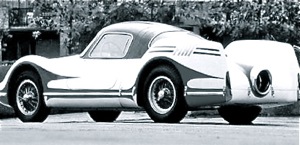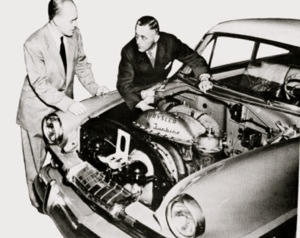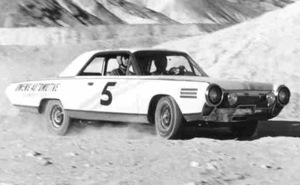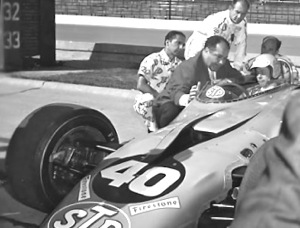by James Kraus

1963 Chrysler Turbine Car
The 1950’s and early 1960’s were the dawn of the jet age and the public clamoured for anything new and futuristic. What could be more alluring than gliding down the road in a jet-powered automobile?
A number of manufacturers toyed with gas turbine developments at this time including Rover, Fiat, Renault, General Motors and Chrysler.
Turbines are ideal in jet aircraft as they run at nearly constant speed. To adapt them for automotive use they had to be modified to provide much faster throttle response and quicker transition times from idle to maximum power. Provision for engine braking was also required as was the necessity for lower exhaust gas temperature.

1950 Rover JET 1
The first ever turbine powered road car was the Rover JET 1 designed by Frank Bell and Spencer King in 1950. The JET 1 introduced a key development in adapting the gas turbine for use in an automobile by adding a second stage turbine that allowed mechanical decoupling of the output of the engine from the main turbine. This allowed the main turbine to spin at its idle speed of 13,000 rpm, while the second stage turbine was stationary.

Schematic Diagram of the Rover JET 1 Powerplant
This was a good thing, as the JET 1 had neither clutch nor transmission. The second stage turbine was utilized in all later automotive turbine engines. The gas turbine was installed in a mid-engine configuration in a heavily modified Rover P4 75 chassis.

Fiat Turbina
The Fiat Turbina was another turbine car with a mid-engine layout, this time utilizing a tube frame that borrowed several components from the chassis of the Fiat 8V Supersonic. It is interesting to note here that it would be a few more years before post-war Formula One cars would appear on the starting grid with mid-engined chassis.

Fiat Turbina at speed; 23 April, 1954
Designed by Oscar Montabone and Vittorio Bellicardi under the direction of Dante Giacosa, the Turbina was demonstrated for the press at the Caselle Torinese airport in the spring of 1954, concurrent with the Turin Auto Show. The futuristic body, drawn by Fabio Luigi Rapi and refined in the wind tunnel at the Turin Polytechnic, had an amazingly low drag coefficient of 0.14 (with rear fender skirts installed), a record-low figure that would stand for decades.

1954 Plymouth with Turbine Power
A few months after the demonstration of the Turbina, Chrysler unveiled their first-generation turbine to the public at the dedication of the new Chrysler Engineering Proving Grounds in Chelsea, Michigan. The engine, installed in a nearly stock 1954 Plymouth, incorporated the second major breakthrough in adapting the gas turbine for automotive use: the regenerator.
The regenerator was a slowly rotating (9-22 rpm) circular honeycomb heat exchanger that recovered heat from the hot exhaust gases and transferred the heat energy to the compressed intake air flowing toward the first-stage turbine. The preheated intake air dramatically improved the fuel efficiency of the turbine by lowering the necessary heat rise to sustain combustion. The regenerator and also served to reduce the heat of the exhaust gases to a safe level within the range of a convention reciprocating engine.

Rover T3
Rover continued research on the turbine concept and in 1956, Spencer King, Gordon Bashford and Peter Wilks developed the Rover T3. This was the first practical road car specifically designed around the gas turbine engine. Retaining the mid-engine layout, the T3 had a purpose-built chassis with four-wheel drive and four inboard disc brakes. The two-seat coupé body was constructed of fibreglass.

Renault Étoile Filante
In September of 1956, Renault took their gas turbine powered Étoile Filante (Shooting Star) to the Bonneville Salt Flats in Utah and set a turbine land speed record of 309 km (192 mph). The car was designed by Fernand Picard and the Turboméca turbine engine was developed by Albert Lory and Jean Hébert. In addition to his engineering and design work on the car, Monsieur Hébert himself took the wheel at Bonneville, setting the top speed record personally.

1958 GM Firebird III
Between 1953 and 1959, GM built a trio of turbine-powered show cars, the Firebird I, II and III. Each was powered by successive generations of the GM Whirlfire turbine engine, designed under the auspices of Emmett Conklin. These vehicles were more renowned for their flamboyant Harley Earl styling and futuristic features such as bubble tops, joystick steering and keyless entry than being turbine powered. The Firebird III had individual compartments and separate bubble canopies for the driver and passenger, restricting potential sales to amorous single male drivers.
Rover, not content with building prototype road cars, partnered with BRM and constructed a turbine powered sports racing car and took it to Le Mans in 1963. Graham Hill and Richie Ginter drove the car in a special ‘Experimental’ classification carrying car number 00. Due to the turbine’s heavy thirst, the car was allowed twice the normal fuel allowance. Had it been running in competition, it would have finished 8th overall.

Rover BRM, 1965 Version
Rover returned to Le Mans with a further developed car in 1965. Among other refinements, the car gained a pair of regenerators that improved the fuel efficiency enough to make the car competitive with the normal fuel allocation. Driven this time by Graham Hill and Jackie Stewart, the Rover finished 10th overall and 2nd in the 2.0 Litre Prototype Category,

Chrysler Turbine Car Prototype
On May 14, 1963, while Rover was preparing for its assault on Le Mans, an even larger event in the history of the automotive turbine was just getting underway. At Roosevelt Raceway in New York, Chrysler unveiled its new Turbine Car to the press. Production (albeit on a limited basis), of a turbine-powered automobile was finally a reality. Nine years after publicly displaying their first turbine prototype, Chrysler, under the direction their Director of Research, George J. Huebner, Jr., designed and built 55 vehicles, specially designed around their fourth generation gas turbine.
Sine 1954, Chrysler had continued turbine research and made large strides in metallurgy which allowed the manufacture of combustion chamber liners, turbine wheels and blades to be made of more affordable alloys with a view toward eventual mass-production. As the engine was developed, they continued testing in existing Chrysler vehicles until the third generation powerplant successfully completed a through testing regime, including a promotional tour across the U.S. At that time, a decision was made to build a small fleet of cars for extended real-world testing by a variety of motorists. Eventually, fifty of the cars were given to 203 motorists throughout the U.S. for successive three-month trials. These cars were designed and built from the ground up to showcase the turbine powerplant.
The fourth generation engine incorporated all the refinements of earlier designs and was the definitive automotive turbine of the 1960’s. A single igniter initiated continuous combustion of pressurized incoming air and the expanding burning gases spun a first stage turbine from an idle speed of 18,000-22,000 rpm to a maximum speed of 44,600 rpm.

Chrysler Turbine Car with 4th Generation Gas Turbine
The gases coming off the first stage turbine were directed to the output turbine by a variable rotary nozzle that increased low speed efficiency and could apply reverse thrust to provide a limited degree of engine braking. The variable nozzle operated in a somewhat similar fashion to the variable torque convertor stator found in some Buick Dynaflow and early GM Turbo-Hydramatic transmissions.
As on the original Rover JET 1, The output turbine had no mechanical connection to the first stage turbine and thus, in combination with the variable nozzle, acted much like the torque converter of a conventional automatic transmission. When the vehicle was sitting at a traffic light for example, the first stage turbine would be spinning at 22,000 rpm, while the second-stage (output) turbine was stationary.
The first stage turbine also powered an air compressor turbine that pressurized the intake air and a pair of stainless steel honeycomb regenerators. As with all turbines, no cooling system was needed. The copious amount of air that flowed through the engine as part of the combustion process kept the engine cool.
To illustrate the volumes of air involved, consider that the two exhaust pipes (rectangular in shape in order to fit under the car) were approximately 637 cm (98 sq in) in cross section. This would equate to dual round exhaust tips of approximately 28 cm (11”) in diameter! These exhausts would make today’s cartoonishly oversized tailpipes seem emasculated. As it was, the engineers kept them discreetly hidden behind the rear valance.

Chrysler Turbine Car Exhaust Gas Outlet (right side shown) Photo courtesy of Mark Olson
Although the engine produced only 130 hp at 3500 output-shaft rpm, this was not representative of the true power output since the engine also had 425 lb-ft (576 N-m) of torque at idle. Opposite to a reciprocating piston engine, a gas turbine produces maximum torque at idle. As rpm increases, the torque output gradually declines. The turbine would run on nearly any combustible liquid, including unleaded regular gas, kerosene, diesel or JP4 jet fuel.
Power was sent to the rear wheels via a modified Chrysler TorqueFlite 3-speed automatic transmission. The most significant modification was to remove the torque converter. Such a converter was unnecessary with the freewheeling output turbine providing the same function as a hydraulic coupling, and of course no torque multiplication was necessary when the power source produced maximum torque at idle speed.
Since a gas turbine produces no engine vacuum, brake assistance was provided by positive air pressure from an small electric pump and reserve tank. Virtually Instant cabin heat was provided by an air-to-air heat exchanger in place of a normal heater core. This was heated by superhot exhaust direct from the combustion chamber, diverted to heat the cockpit before reaching the regenerators.
The Turbine Car’s body was styled by ex-Ford designers Charles Mashigan and Elwood Engle and was very derivative of the 1961 Ford Thunderbird in both side profile and frontal view. The rear was borrowed almost intact from the 1958 Ford LaGalaxie concept car.
Complete bodies and interiors were built by Ghia in Italy and shipped to Chrysler for installation of the drive train. Using a technology that is just now becoming common in some recent production cars, the front and rear deck lids were fabricated of aluminium, the inner and outer sections bonded together with structural adhesive.

1963 Chrysler Turbine, Production Version
The prototype Turbine Car was finished in Pearl White with darker silver sills giving a low, lean look. Overall, it was an attractive, subtly futuristic design, well suited to its mission of showcasing turbine technology. Unfortunately, for the production run, the colour was changed to Turbine Bronze. Against the Bronze, the silver sills, which had appeared dark on the white car, now appeared light, and made the car appear both taller and bulkier. Worse, a vinyl top covering was added, a strange retro-item on a car that was otherwise pointing toward the future. The headlamp surrounds, reversing lamps, full-length interior centre console and other details were executed in a turbine blade motif.

Chrysler Turbine Interior
Four individual bucket seats and full-length console were hallmarks of the futuristic interior, which was fully upholstered in leather including the sun visors and the sides of the outboard front seat tracks. The instrument panel featured glare-reducing electroluminescent instruments, a technology originally co-developed with Sylvania for use in the quarter-sphere AstraDome instrument pod of the 1960 Chryslers. All controls, with the exception of the radio, were located on the centre console.
In addition to those requisitioned for the Customer Research Program, additional Turbine Cars were taken on a international 21-country publicity tour of shopping centres, colleges and the 1964-1965 New York World’s Fair. In Mexico, upon request of President Alolfo López Mateos, the Turbine Car was operated on Tequila, while driven personally by El Presidente.

Chrysler Turbine Car in the 1964 Film, “The Lively Set”
The Chrysler Turbine Car also starred in a 1964 film, The Lively Set, featuring James Darren, Doug McClure and Mickey Thompson in a cameo role playing himself. As Chrysler would not allow anyone else drive what was still a prototype, the Turbine Car in the film was piloted by none other than George Stecher, the chief mechanic of the Chrysler Turbine program who, by necessity, became a card-carrying member of the Screen Actors Guild.

1967 STP Paxton Turbine
While a few previous teams had raced turbine powered cars at the Indianapolis 500, none were successful. This all changed in 1967 when Parnelli Jones, driving Andy Granatelli’s STP Turbine car, virtually dominated the race until three laps from the finish when a transmission bearing failed, dropping the car to 6th place. Pete Lyons, writing about the race years later in Motorsport, reported that Jones later remarked that he might have taken it easier accelerating out of the pit lane after his final refuelling…
In 1968, STP started from scratch with a new Lotus-designed chassis. Joe Leonard was leading the race in this new STP Turbine with ten laps remaining when a fuel pump drive shaft failed, leaving him to finish in 12th position. While the turbines didn’t survive to win, they left their mark.

Howmet TX Continental Turbine at Daytona; 4 February 1968 Photo: Bob d’Oilvo
1968 also saw the turbine-powered Howmet TX Continental compete in the FIA Group 6 World Sportscar Championship. Like the STP racers, the Howmet was powered by a gas turbine engine originally designed for helicopter use. The best result came at the Six Hours of Watkins Glen, where Dick Thompson and Ray Heppenstall drove the turbine to third overall, behind two Ford GT40’s. The Howmet also competed in and won some regional and national Sports Car Club of America races, making the TX Continental the only turbine-powered racing car to achieve overall victory.
Two of the surviving Howmet’s are active in historic racing. Frenchman Xavier Micheron will be taking his to England next month for the final round of the 2009 Classic Endurance Championship at Silverstone.

Emerson Fittipaldi at the wheel of the Lotus 56B Turbine, Italian Grand Prix, Monza; 5 September 1971
Building on the experience gained designing the 1968 STP Turbine, Lotus fielded a turbine-powered Formula One car during the 1971 Grand Prix season, but the lack of engine braking was a severe detriment on road courses and the car failed to garnish any points toward the Constructors Championship. The turbine’s best result was 8th at Monza, driven by Emerson Fittipaldi.
The smoothness, simplicity and light weight of the gas turbine were unfortunately not enough to overcome poor fuel economy and lackadaisical throttle response. While the Chrysler Turbine Car Customer Research Program was underway, Huebner and his team developed a fifth generation turbine that incorporated larger regenerators and a higher operating temperature to address these issues.
This engine was planned for a limited 500-car production run of specially modified 1966 Dodge Chargers. During this time, however, the Unites States passed the Motor Vehicle Air Pollution Control Act of 1965, which would begin limiting environmentally harmful emissions of automobiles beginning in January of 1968. Due to the extremely high combustion temperature of the gas turbine, it produces much higher levels of nitrogen oxides than equivalent reciprocating engines. Chrysler realized they would be unable to meet the proposed nitrogen oxide emission standard with current turbine combustion chamber design and held off on moving forward.
Although Chrysler continued development of the gas turbine through 1979, they returned to testing the engines in various standard production Chrysler vehicles. Thus, the purpose-built Turbine Car will forever remain the pinnacle of Jet Age turbine power.
Here is a short film of the Bicknell family in San Diego, California driving their Chrysler Turbine Car to a most appropriate mid-sixties destination: a Polynesian Tiki restaurant, the Bali-Hai, for some Bongo-Bongo Soup, Tiki-Nest Wontons and Shrimp Luau:
>
For more on the Chrysler Turbine Car, visit Turbinecar.com
A DVD of The Lively Set is available from Lost Treasure.
Not to take away from the driving skills of Emerson Fittipaldi; but it would be interesting to speculate as to what results the Lotus 56B Turbine might have achieved had Jim Clark still been alive and driving for Lotus.
The Howmet TX is a good example of the benefit of the high low-speed torque of the gas turbine. In 1970, the car set an FIA-sanctioned turbine speed record in the standing-start 1/4 mile of 11.8 seconds. An amazing figure considering its single-speed gearbox.
“Project Typhoon” just premiered at an independent film festival in Los Angeles last week. It is a new 48-minute documentary on the development of the Chrysler Turbine car. Hopefully a DVD version will be released soon.
The History Channel’s website offers an earlier DVD on the history of the Chrysler Turbine car:
http://shop.history.com/detail.php?p=74252&v=All
I was quite fascinated by the Chrysler Turbine Car and followed its development back in the ’60’s. I am in complete agreement as to preferring the car in white over the bronze/black vinyl combination. What I can’t decide is whether I prefer it with the standard rear wheel skirts fitted or without (as driven in the “Lively Set” movie)
Very nice piece of work.
The only thing that is missing for me is any mention of the Rover T4 (definitely the closest a gas turbine got to becoming a proper everyday car) which was close to a prototype for the Rover P6 built between 1963-77.
The Rover P6 was designed and built with the turbine in mind, even if it never one had one fitted. The engine bay and front suspension set up was all ready for the turbine.
Its just a shame that the British Government put the testing of the commercial truck version engines in the hands of the oil companies. Big mistake.
Mark Gray
Editor, Driving Force
The Rover P6 Club
Actually, the Chrysler has to get the nod for being “the closest a gas turbine got to becoming a proper everyday car” because over 200 everyday motorists did in fact actually use one on an daily basis for three full months.
Pingback: Hooniverse Asks- What’s the Best Jet or Space-Related Car Name? : Hooniverse
I should like to add the Grégoire to this wonderful collection, which inspired the fictionnal, yet so famous TurboTraction by the Belgian cartoonist André Franquin for his cartoon hero, Spirou:
http://automobile.challenges.fr/dossiers/731/article.html
http://www.motorlegend.com/concept-car/socema-gregoire-/6,10944.html
http://www.automag.be/La-Turbotraction-de-Spirou-a-bien
http://club.doctissimo.fr/phedor/blog/gregoire-voiture-spirou-2263661.html
http://www.autoweb-france.com/essais/Turbot/essai_222_Turbot_Rhino_I_(Turbotraction).php
There were two models of the Turbotraction: the Turbo Rhino I and II, the former owing its name to a rhino hunt to recover the prototype’s blueprints (“La corne du rhinocéros”), the latter, a modern 1960s version, which appeared after the first model was destroyed in a horrific crash (“Vacances sans histoire”).